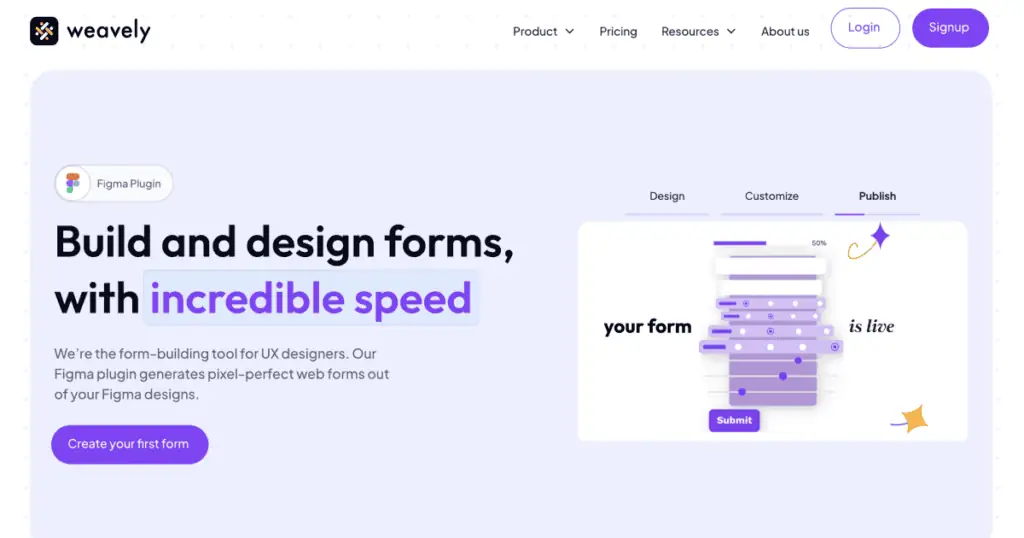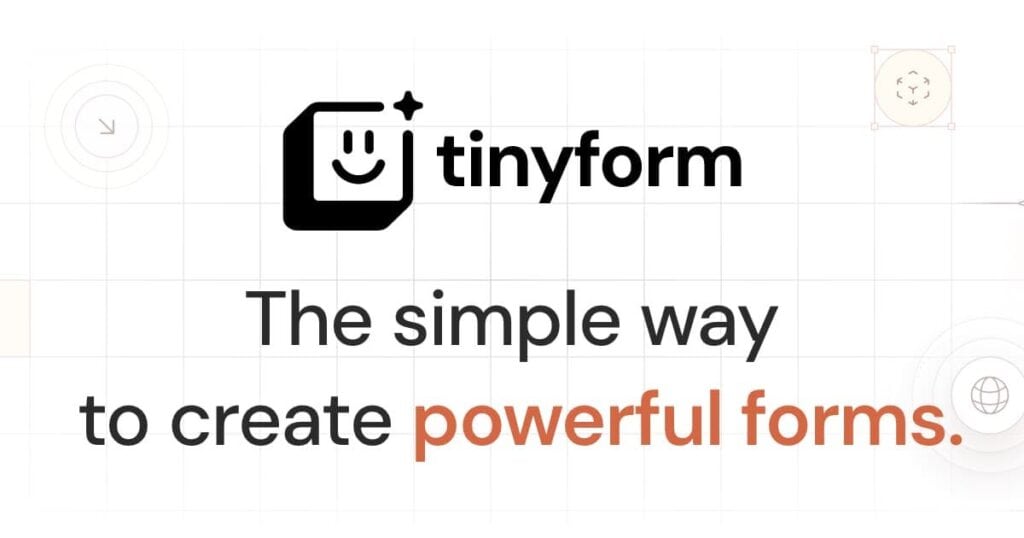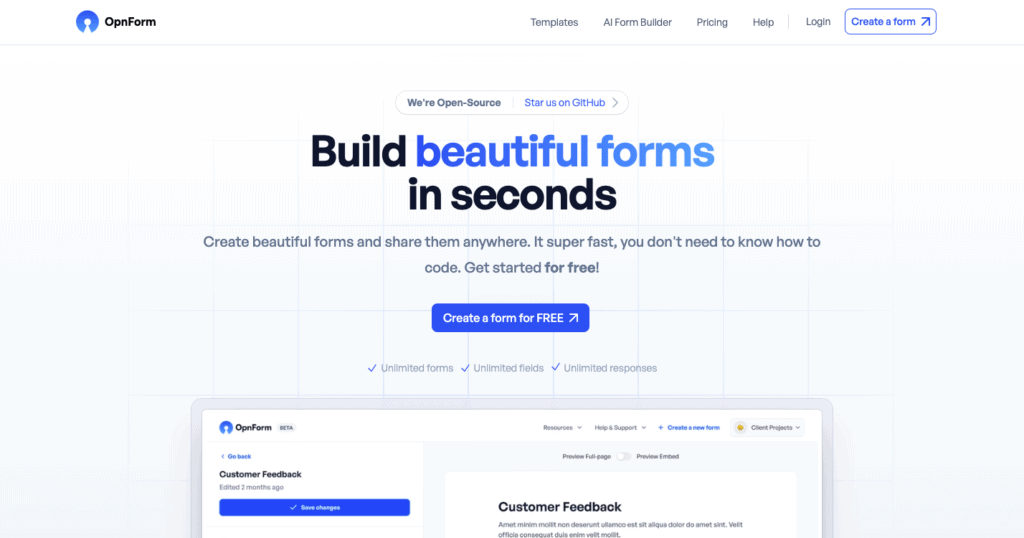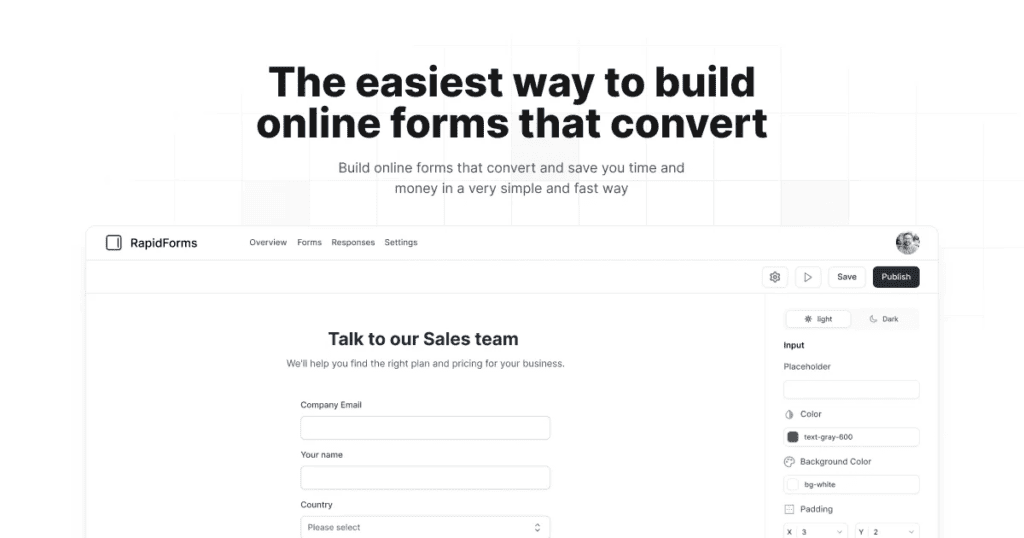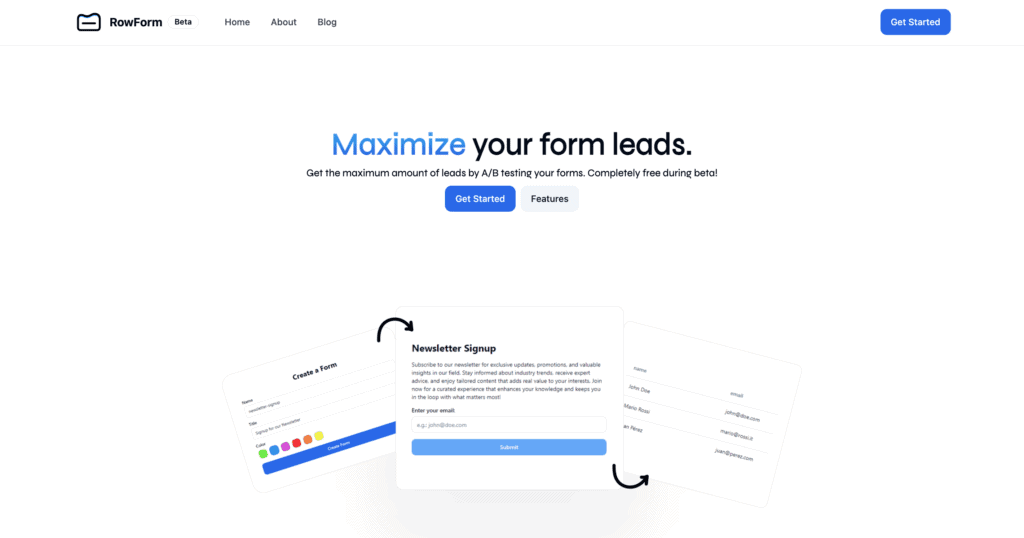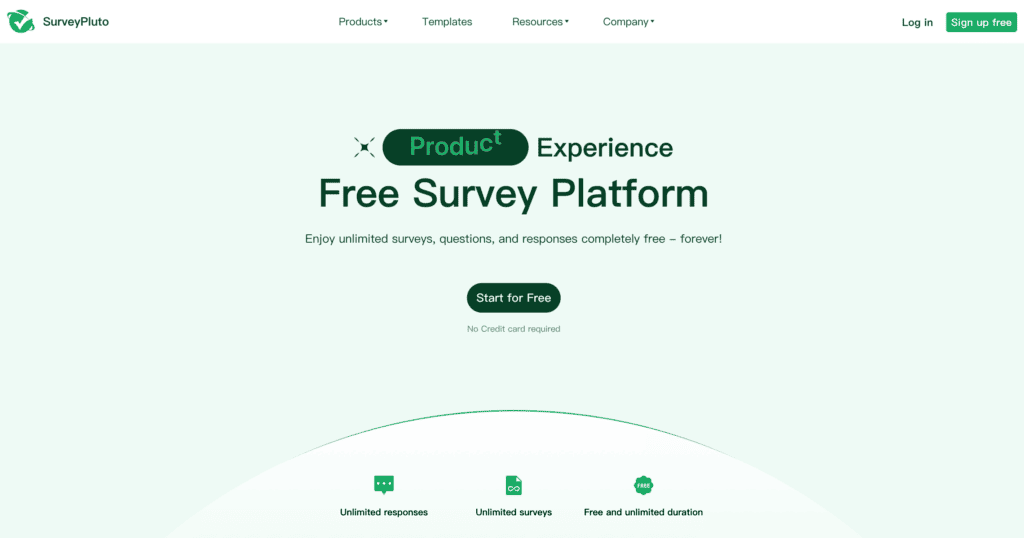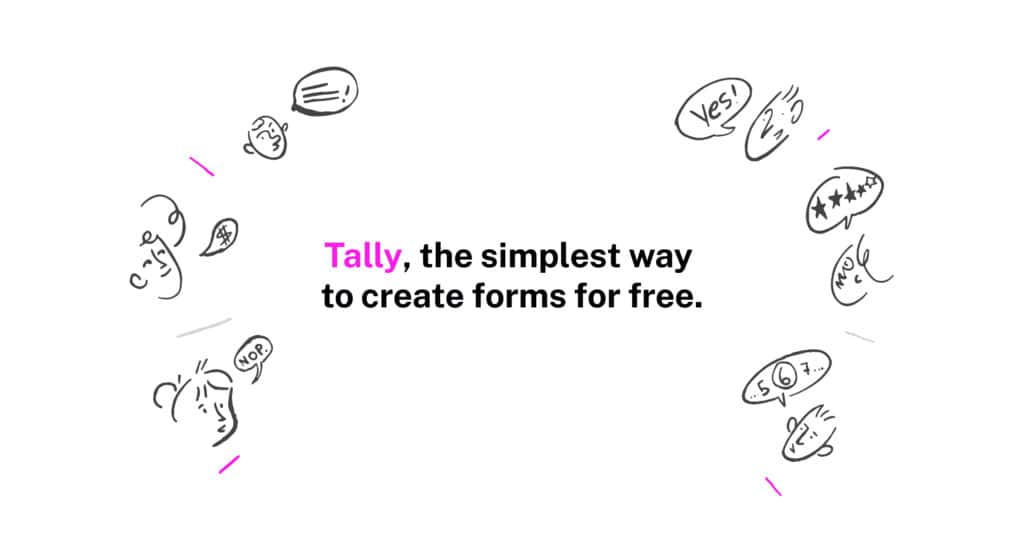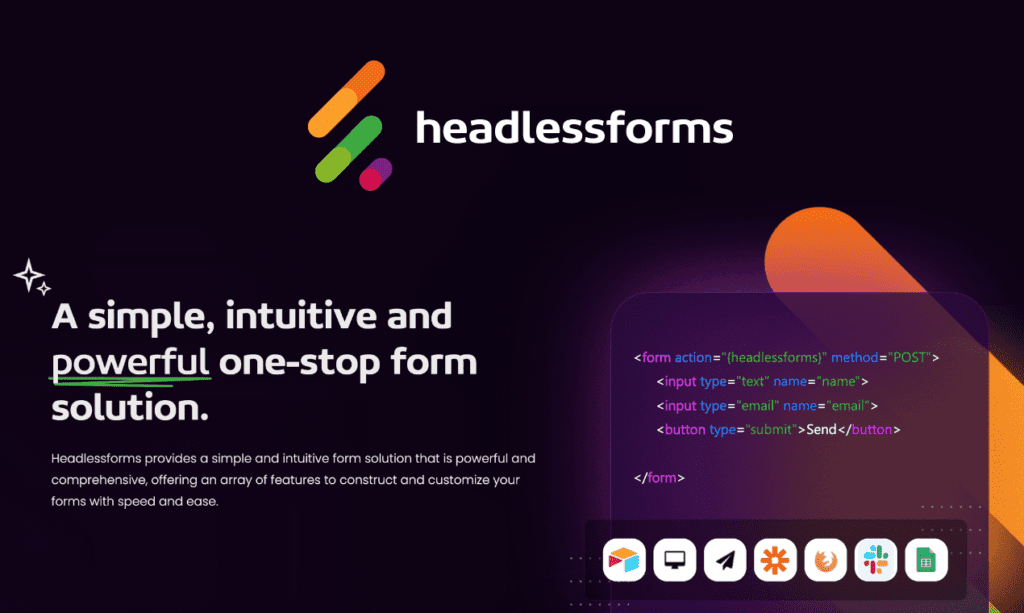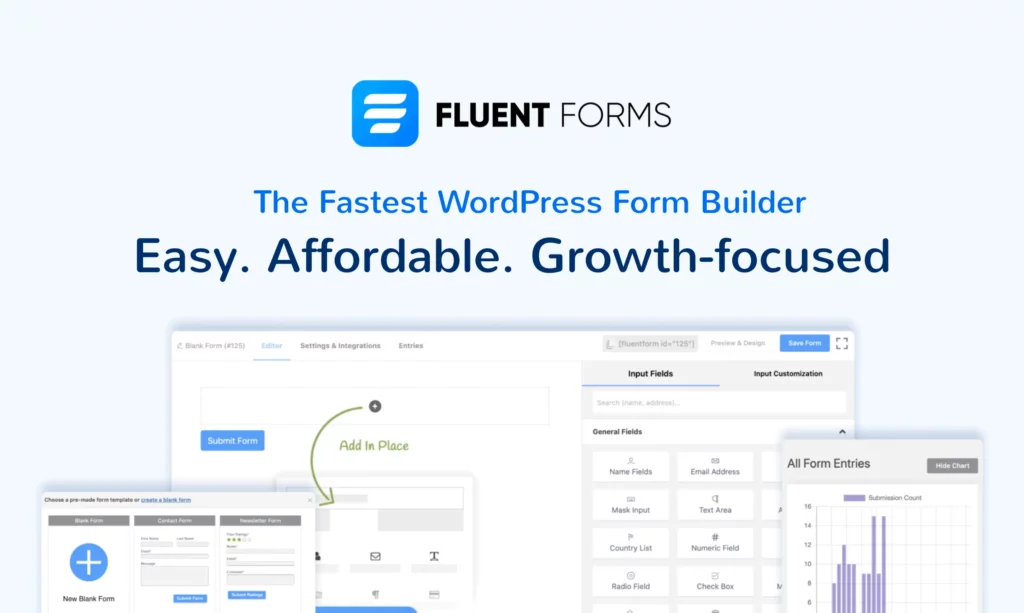Fillout
Read more about Fillout

Finding the right form builder software is crucial for anyone looking to collect information efficiently. With the vast array of options available, understanding what makes each tool unique can help streamline your decision-making process. Whether you’re aiming to enhance customer engagement, gather data, or automate workflows, the ideal form builder software should cater to your specific needs while offering user-friendly features.
Online form builders have revolutionized the way we collect and analyze data, offering extensive customization and integration capabilities. They allow you to create forms quickly, embed them on websites, and collect responses in real-time. The automation opportunities they present can significantly reduce manual work, enabling you to focus on more strategic tasks.
However, with the multitude of options comes the challenge of choosing the one that best fits your requirements. Factors such as ease of use, customization options, integration capabilities, and pricing play a significant role in the selection process. It’s essential to consider these aspects alongside your specific objectives and the type of data you intend to collect.
This guide aims to provide you with a comprehensive overview of the top form builder software, highlighting their key features, benefits, and potential drawbacks. By understanding what each platform offers, you can make an informed decision that aligns with your goals, ensuring a seamless data collection and analysis process.
As you navigate through the myriad of form builder software choices, key players like Jotform, Google Forms, Microsoft Forms, and others stand out for their unique capabilities. From template-rich environments to seamless Microsoft 365 integrations, each offers distinct advantages for creating online forms. The ability to embed forms easily across various platforms further enhances their utility, making them indispensable tools for businesses and individuals alike.
Jotform sets itself apart as a leader among online form builders, offering a vast template library that caters to various needs. Its intuitive interface simplifies the form creation process, allowing users to customize templates to fit their specific requirements. Whether you’re organizing an event or collecting feedback, Jotform provides the tools you need to create effective online forms quickly.
One of the main attractions of Jotform is its extensive template library, which offers a wide range of form types to suit different purposes. This feature saves you time and effort, enabling you to deploy forms swiftly. Additionally, Jotform supports the creation of fillable PDFs, a unique capability that allows for offline data collection and further extends its versatility.
The platform’s customization options empower you to tailor forms to your branding, ensuring a coherent user experience. With Jotform, you also gain access to a host of integrations, enhancing your forms’ functionality and making it easier to manage the data you collect. Whether for registration, order forms, or surveys, Jotform delivers a robust solution that meets diverse needs.
Google Forms is renowned for its ability to create powerful forms swiftly. As part of the Google Docs suite, it offers seamless integration with other Google services, enhancing its utility for collecting data. Its straightforward design tools help you create forms that match your brand, ensuring consistency across your landing pages. With Google Forms, you can enjoy high conversion rates and a variety of payment options, making it a versatile choice for various applications.
Google Forms stands out for its simplicity and effectiveness, providing users with a straightforward platform for creating forms. Its integration with Google Docs facilitates easy data collection and analysis, streamlining the process of gathering insights. The platform’s customization capabilities allow you to create forms that reflect your brand identity, enhancing the overall user experience.
Moreover, Google Forms supports various payment options, making it an excellent tool for transactions and registrations. Its ability to deliver high conversion rates on landing pages further underscores its value as a formidable tool for form creation. Whether for surveys, feedback, or event registrations, Google Forms offers a reliable and efficient solution.
Microsoft Forms is the go-to choice for seamless integration with Microsoft 365, offering a cohesive environment for users of Microsoft apps. It excels in creating customized forms, including feedback forms, that can be easily shared within the Microsoft ecosystem. The platform enables users to tailor forms to their specific needs, making it an excellent tool for businesses and educators alike.
Microsoft Forms is highly regarded for its deep integration with Microsoft 365, allowing users to leverage their existing suite of Microsoft apps to enhance form functionality. This integration simplifies the process of sharing and collaborating on forms within organizations, enhancing productivity. Its customization options are robust, enabling the creation of feedback forms that can be tailored to gather the exact data needed.
The ability to customize forms to a high degree ensures that they align with your organization’s branding and objectives. With Microsoft Forms, you can create surveys, quizzes, and polls that look professional and are optimized for response rates. Its intuitive design and seamless integration with other Microsoft apps make it a top choice for users entrenched in the Microsoft ecosystem.
Cognito Forms emerges as the top choice for collecting payments, thanks to its advanced features like conditional logic, unlimited forms, and integration with Stripe. Its sheets integration and comprehensive reports section further augment its utility, making it a powerful tool for businesses that require sophisticated form capabilities. Whether for orders, donations, or registrations, Cognito Forms simplifies the payment collection process.
The platform’s use of conditional logic allows for dynamic forms that adapt based on user input, providing a personalized experience. Moreover, the ability to create unlimited forms ensures that your business can cater to various needs without restrictions. Integrating with Stripe for payment processing, Cognito Forms offers a seamless financial transaction experience, bolstered by its sheets integration for data management.
The reports section of Cognito Forms is another significant advantage, offering in-depth insights into form performance and user responses. This feature is invaluable for businesses looking to analyze data for informed decision-making. With its combination of payment processing, conditional logic, and comprehensive reporting, Cognito Forms stands out as a robust solution for any organization’s form-building needs.
Zoho Forms is recognized for its superior handling of team collaboration and approval flows, making it an ideal choice for businesses that require structured processes. Its integration options with the broader Zoho software suite enhance its functionality, allowing for a seamless workflow across various business applications. Whether for HR processes, customer feedback, or project management, Zoho Forms facilitates efficient team collaboration.
The platform’s integration options with the Zoho software suite enable businesses to streamline their operations, linking form data with other business processes effortlessly. This capability is particularly beneficial for teams that rely on seamless data flow between applications. Additionally, Zoho Forms is designed to support complex approval flows, ensuring that form submissions undergo the necessary review and approval processes.
Its focus on team collaboration makes Zoho Forms a standout choice for organizations that prioritize efficiency and process integrity. The software suite’s comprehensive features, combined with the form builder’s robust functionality, provide a powerful tool for managing forms across various departments. Zoho Forms’ ability to integrate tightly with other Zoho applications further cements its position as a top choice for businesses seeking to optimize their form-related workflows.
In the realm of form builders, specialized needs often require specialized tools. Platforms like Typeform leverage conditional logic to create dynamic, engaging forms tailored to the user’s responses, making them ideal for surveys, quizzes, and more personalized interactions. This specialization ensures that your forms not only gather data effectively but also enhance the user experience, making them invaluable for specific applications.
Typeform sets the standard for conversational forms, transforming the traditional form-filling experience into an engaging dialogue with the user. This approach helps to gather data in a more natural and interactive manner, improving completion rates and the quality of information collected. Typeform’s unique design and user interface stand out in the crowded form builder market, offering a refreshing alternative for data collection.
The platform’s emphasis on conversational forms creates a more personal and engaging user experience. This approach not only makes form filling less tedious but also encourages users to provide more thoughtful and thorough responses. Additionally, Typeform’s limited free plan offers an accessible entry point for businesses and individuals to explore its capabilities, with the option to scale up as needs grow.
Beyond its engaging interface, Typeform integrates with a wide range of tools, enhancing its utility and allowing for seamless data collection and analysis. Whether for market research, customer feedback, or event registration, Typeform’s conversational forms offer a unique and effective way to connect with your audience and gather valuable insights.
Feathery stands out for those who love diving into complex form logics and sophisticated user experiences. Its robust capabilities support intricate form designs, making it a favorite among developers and tech-savvy marketers. Feathery’s integration with key platforms like Zapier and HubSpot, along with its ability to handle online payments, positions it as a highly flexible tool for crafting interactive online forms.
One of the biggest advantages of Feathery is its seamless Zapier integration, which opens up a multitude of automation possibilities. Whether you’re looking to connect your forms with CRM, email marketing tools, or databases, Feathery makes it simple. Moreover, its ability to process online payments directly through forms is a game-changer for businesses looking to streamline their e-commerce or fundraising efforts.
Another significant benefit is the platform’s flexibility and advanced logic capabilities. Feathery allows for the creation of dynamic, responsive forms that can adapt based on user inputs, creating a personalized experience for each user. This level of customization ensures that forms can serve a wide array of purposes, from simple surveys to complex registration processes.
WuFoo is a powerhouse for those needing efficient online forms that also serve as robust data collection and analysis tools. It simplifies the form creation process without compromising on the depth of features, including detailed analytics and reporting. WuFoo’s forms are easy to integrate across websites, making it a versatile choice for businesses, educators, and event organizers.
One of the standout features of WuFoo is the ability to embed forms directly into your site. This functionality ensures a seamless user experience, keeping visitors on your page without redirecting them to complete a form. Additionally, WuFoo’s comprehensive analytics allow for an in-depth examination of form responses, helping you to make informed decisions based on user feedback and behavior.
WuFoo also excels in customization and design flexibility. Despite its powerful backend, it offers a wide range of templates and design options to ensure your forms not only function well but also match your site’s aesthetics. This balance between form and function epitomizes WuFoo’s approach to online form building.
Formstack emerges as the go-to choice for regulated industries, thanks to its strong emphasis on data security and compliance. Its advanced analytics and conversational forms enhance user engagement, while integrations with Microsoft Forms, Google, and Zapier interfaces ensure seamless workflow automation. The platform’s focus on creating powerful forms that meet strict industry standards makes it invaluable for healthcare, finance, and education sectors.
Formstack sets itself apart with its integration capabilities, notably with Google Analytics for tracking form performance and QR codes for easy access. However, what truly makes Formstack shine is its approach to data gathering. The platform allows for a sophisticated yet straightforward way to gather data, which, when combined with its limited design restrictions, offers both functionality and customization.
Moreover, Formstack’s emphasis on security and compliance addresses the critical needs of regulated industries. Features such as advanced encryption and compliance with various standards ensure that sensitive information is handled safely, making it a trustworthy option for any organization that prioritizes data security.
Zapier Interfaces revolutionize how we think about automation in form building and data management. By offering an app builder and generous free plan, Zapier Interfaces enable users to create custom solutions that connect their favorite tools, enhancing productivity and efficiency. The customer support portal ensures that help is always at hand, making it approachable for both beginners and advanced users.
The app builder feature within Zapier Interfaces allows for unprecedented customization and automation, making it possible to connect and automate workflows across hundreds of apps without writing a single line of code. This flexibility is a significant advantage for businesses looking to streamline their processes.
Furthermore, the strength of Zapier lies in its interfaces, which provide a user-friendly platform for setting up complex integrations. This ease of use, combined with a generous free plan, makes Zapier Interfaces an attractive option for businesses of all sizes seeking to enhance their productivity through automation.
In today’s digital landscape, the ability to seamlessly integrate and automate business processes is not just a convenience—it’s a necessity. Form builder software has evolved to not only collect information efficiently but also to assign forms and enforce business rules automatically, streamlining operations and ensuring consistency across various platforms.
Automating workflows with form builder software, especially using tools like Microsoft Forms, transforms tedious manual tasks into streamlined processes. By setting up forms to trigger specific actions in other applications, businesses can save time and reduce errors. This automation extends to tasks like data entry, email notifications, and updating records, making workflows more efficient.
Moreover, the integration capabilities of modern form builder software mean that these automated processes can seamlessly connect with your existing tools, such as CRM systems, databases, and project management tools. This connectivity ensures that information flows smoothly between platforms, keeping teams informed and responsive to new data.
Integrating form builders with CRM and other business tools has become a cornerstone of effective digital strategy. This synergy allows for the automatic capture and organization of leads, customer feedback, and other vital data directly into your business’s workflow, enhancing efficiency and responsiveness.
The integration of CRM systems with online form builders streamlines the lead capture process, automatically updating customer records and ensuring that no valuable information slips through the cracks. This real-time data flow enhances customer relationship management, allowing for more personalized interactions and timely follow-ups.
Additionally, this integration facilitates better segmentation and analysis of customer data, enabling targeted marketing campaigns and strategic decision-making based on accurate, up-to-date information.
Zapier serves as a bridge between form builders and a vast array of other tools, enabling even those with limited technical expertise to set up complex automations. By connecting form responses to applications like email marketing services, project management tools, and customer support platforms, Zapier automates routine tasks and ensures efficient workflow management.
This level of automation not only saves time but also allows businesses to respond more quickly to customer inquiries, manage projects more effectively, and maintain up-to-date records without manual data entry. The result is a more agile, responsive organization that can adapt quickly to changing business needs.
In an era where data breaches are a constant threat, enhancing the efficiency and security of online forms is paramount. Form builder software now comes equipped with features designed to optimize the user experience while safeguarding sensitive information, ensuring that data collection is both user-friendly and secure.
To create effective online forms, it’s essential to focus on clarity and simplicity. Using tools like Microsoft Forms, ensure your forms are straightforward, asking only for information that is absolutely necessary. This approach minimizes user frustration and increases the likelihood of form completion. Incorporating powerful forms with advanced analytics can also provide insights into how users interact with your forms, allowing for continuous improvement.
Conversational forms, enhanced by Zapier interfaces, can significantly improve user engagement by making the form-filling process more interactive and less monotonous. This personal touch encourages users to complete forms, providing you with the data you need while offering them a more enjoyable experience.
When you use online forms, keeping your information safe is a big deal. Imagine you’re locking up your personal details in a safe. You wouldn’t want anyone just walking in and taking them, right? That’s why it’s important to choose form builders like Cognito Forms. They are like having a strong safe. They make sure your information is protected so that only the right people can see it. Think of it as having a secret code that only you and the people you trust know.
To keep your data safe from leaks, imagine you’re building a fortress around your information. First, using tools like Cognito Forms helps because they’re designed to keep your data locked up tight. They use special tech stuff to make sure no one can sneak in and see your info. It’s like having guards who are always watching.
Next, always make sure you’re sending your info over a secure connection. This is like making sure the drawbridge to your fortress is up, so only the right people can cross. If you’re careful about how you send and store info, you can keep it safe from the bad guys who want to sneak a peek.
Keeping your forms private is like keeping a diary under lock and key. First, using Microsoft Forms gives you powerful forms that are safe to use. They make sure only you and the people you pick can see what’s inside. It’s like having a diary that only opens with your fingerprint.
Then, add tools like Zapier interfaces to connect your forms with other apps safely. This way, you can move your info where it needs to go without worrying. Think of it as having secret passageways between your rooms that only you know about. By doing these things, you can keep your form data safe and sound.
Choosing the right form builder is like picking out the best tools for a project. You have to think about how much you want to spend and who will be using them. Some tools are free, like a simple hammer, while others cost more but do a lot more, like a fancy power drill. You also want to make sure everyone can use these tools, no matter if they’re a pro or just starting out. It’s all about finding the right balance.
When you’re looking at form builders, think of it as shopping for apps. Some are free, like Cognito Forms, which lets you make unlimited forms without spending a dime. They’re great if you’re just starting or if you need basic forms. But, they might ask for money if you want to start accepting payments or use fancy design themes. It’s like getting a basic app for free but paying for extra cool features.
On the other hand, paid options give you more from the start. You might get better security, more design options, and tools like input validation, which checks the info people put in your forms to make sure it’s right. Think of it as buying a premium app that comes with all the bells and whistles. You have to decide what’s best for you – saving money or having more features from the start.
When making forms, think about everyone who might use them. Microsoft Forms is good at this because it’s made so everyone can fill out forms easily, no matter if they find using computers hard or easy. It’s like making sure there’s a ramp in a building so everyone can get in. You want to make sure no one is left out.
Creating professional-looking forms that everyone can use is important. It’s like writing instructions that everyone can understand. You want to make sure that the colors are easy to see and that the form can be read by screen readers, which are tools that read out loud for people who have a hard time seeing. This way, everyone can fill out your forms without trouble.
Also, think about making your forms simple to navigate. Avoid making them too complicated. It’s like making sure a door is not too heavy for someone to open. By doing these things, you help everyone share their info with you easily.
When deciding on premium features in form builders, think of it like choosing extras for a new car. Some features, like management software, can make your life a lot easier by helping you sort and understand the info people give you. But, they can cost more.
Ask yourself if these extras are worth the money. Do they make your forms much better? It’s like deciding if you need heated seats in your car. They’re nice to have, but do you really need them? Making smart choices here can save you money and still get you a great form builder that meets your needs.
Experts who know a lot about form builders can give you great advice. They’ve seen it all and can tell you which tools work best for making forms that people will want to fill out. They might talk about how using Zapier interfaces can connect your forms to other apps without a lot of hassle. It’s like getting a recipe from a great cook. You know it’s going to be good.
Experts say using online form builders is like having a superpower for collecting info. They love how tools like Zapier interfaces can automate workflows, making life easier. This means your forms can do more, like sending info automatically to where it needs to go. It’s like having robots do your chores.
They also talk about the importance of a good internet connection and deep integration with apps like Stripe for payment forms. This way, you can make forms that not only collect info but also handle money safely and easily. It’s like turning your forms into multitasking wizards.
Thinking about the future of form builders is exciting. It’s like imagining what new gadgets we’ll have. Experts think we’ll see more smart tools that can guess what info you need and help you make forms faster. It’s all about making your job easier.
Soon, tools like AI and machine learning could help make registration forms by themselves. Imagine typing in what you need, and poof, your form is ready. This tech could learn what works best and keep making better forms. It’s like having a smart assistant who learns what you like.
These smart tools might also help you understand the info you collect better. They could spot trends or even suggest how to improve your forms. It’s like having a detective who helps you see clues in your data that you didn’t notice before.
More and more, making forms that work well on phones is becoming important. It’s like knowing that everyone uses their phone for everything, so your forms need to be easy to use on small screens. This means big buttons, easy-to-read text, and forms that load fast.
Also, think about how people use their phones. They might be on the go, so your forms should be simple and quick to fill out. It’s like making a door that’s easy to open, even when your hands are full. By doing this, you make sure no one gets frustrated and gives up on filling out your forms.
Choosing the right form builder is a big decision. It’s like picking the right tool for a job. You want something that fits your needs, whether that’s making simple forms or something more complex. Think about what features you really need, like customization options or mobile applications.
Remember, the best form builder for you is one that matches what you’re trying to do. Whether you need to collect sign-ups, gather feedback, or handle registrations, there’s a tool out there for you. It’s like finding the perfect pair of shoes; when you find the right fit, everything feels easier.
Finding the form builder that’s right for you comes down to knowing what you need. If you’re all about managing projects, look for something with strong project management features. Also, think about how your forms will look on mobile devices since a lot of people use their phones for everything.
And don’t forget about the future. Choose a form builder that can grow with you. Maybe right now, you don’t need all the fancy features, but it’s good to have the option as you grow. It’s like planting a tree; you want to make sure it has enough room to get bigger over time.
Online forms have transformed the way you gather information, enabling efficient data collection and analysis. With the introduction of platforms like Zapier interfaces, integrating forms with other tools has become seamless. This evolution has led to the creation of mobile forms that can reach over 25 million users worldwide, ensuring accessibility and convenience. The ability to convert data to Google Sheets or store it on cloud storage like Google Drive has revolutionized data handling, making it easier for you to manage customer feedback and grow your business.
Looking ahead, the future of online forms is bright, with innovations focusing on custom forms that cater to specific business needs. The emergence of AI and machine learning will further personalize the form creation process, allowing for more dynamic and interactive application forms. As you strive to create more engaging and efficient forms, the ability to use templates and customize them with 41 themes will enhance user experience. The focus will also be on ensuring forms are accessible on mobile devices, acknowledging the minimum and maximum requirements of custom mobile applications, thereby expanding your reach and improving data collection methods.





